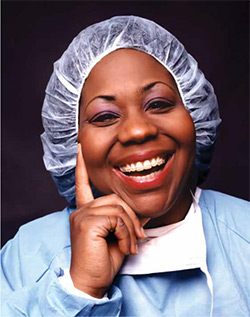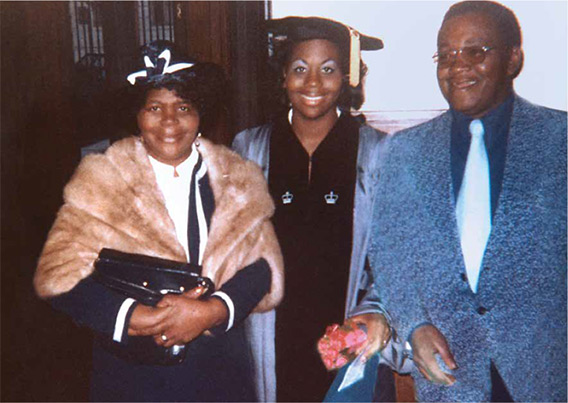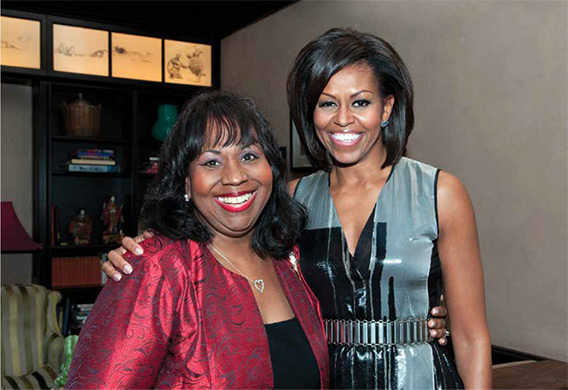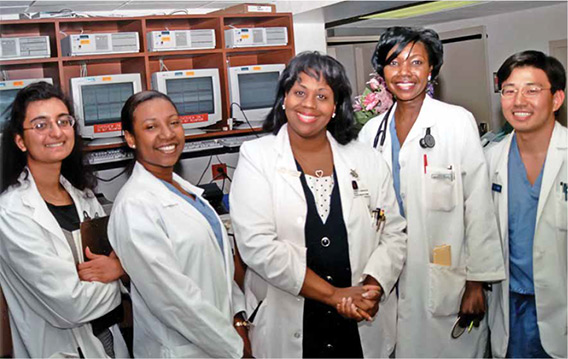Alumni Profile: Yvonne Thornton’73/’96 MPH

Best known for her instrumental role in refining and helping win FDA approval for the practice of chorionic villus sampling (CVS), an alternative form of prenatal diagnostic testing that can be performed safely and with minimal discomfort to the mother much earlier than amniocentesis, pioneering perinatologist Yvonne S. Thornton’73, MPH’96 broke two glass ceilings. She is the first African-American woman in the United States to be board-certified in high-risk obstetrics and the first to be accepted into the highly selective New York Obstetrical Society.
Having risen from modest means and surmounted obstacles of race and gender prejudice to reach the leading ranks of her specialty, she proudly fulfilled her father’s dream that his daughters become doctors. Personally delivering more than 5,000 babies and overseeing or supervising more than 12,000 high-risk deliveries in the course of her career and pursuing landmark clinical research on weight gain prevention intervention in obese pregnant women, she managed to do it all while raising a family of her own. Her son, Shearwood III (Woody), a 2004 VP&S graduate, and daughter, Kimberly, are both MDs.
Dr. Thornton chronicled her experiences in two best-selling memoirs, “The Ditchdigger’s Daughters,” subsequently made into an award-winning movie and recently optioned for a Broadway musical, and “Something to Prove,” the grand prize winner in the 2011 New York Book Festival.
In September 2017 she revisited her medical alma mater to talk about her life and career with Columbia Medicine.
“I Want to be Around When One Person Becomes Two People”
Dr. Thornton’s calling in life became clear to her early on. At 8 years old, on a visit to the hospital with her aunt, a registered nurse, she witnessed a woman giving birth in an elevator and resolved, “I want to be around when one person becomes two people!”
One of six daughters (including one adopted daughter) of the late Donald and Itasker Thornton, Dr. Thornton says her parents worked tirelessly, her father holding down two and sometimes three jobs at a time and her mother cleaning other people’s houses as well as her own, to put food on the table, to put clothes on their backs, and to move the family from the projects to a real home that Mr. Thornton built from scratch in Long Branch, N.J. Her mother, who had always regretted interrupting her studies at a historically black college, Bluefield State Teacher’s College (now Bluefield State College) in Bluefield, W.Va., because she didn’t have the money to pay the tuition, framed and treasured every diploma her daughters earned. Given to reciting verses by Keats and Wordsworth while scrubbing floors, she convinced her husband, himself a high school dropout with a sharp mind, that education was a top priority.
Some people are content to dream. Others do everything in their power to realize their dreams. Bucking the odds against a black, working class family in the 1950s, notwithstanding the ridicule of neighbors and co-workers, Donald Thornton decided that his daughters would become doctors. A homespun philosopher, he imbued in his children his own single-minded determination to achieve a better life for them. “If the front door isn’t open,” he said, “go around to the back and climb through the window. If the window is closed, try to get in through the cellar. If that’s locked, go up on the roof and see if you can get in through the chimney. There is always a way to get in if you keep trying.” As to the challenges ahead, he laid it on the line: “You’re black and you’re girls, and the world has already written you off.” A realist with a dogged optimistic streak and a can-do attitude, he nevertheless insisted: “This country gives blacks a lot of grief. But it gives them a lot of opportunities too. Work hard and people will help you; doors will open.”
The stethoscope, or what he liked to refer to as “that scripperscrap,” was more than a mere medical device to him. A symbol of care, it also leveled the playing field. “When someone’s in need of healing,” Mr. Thornton reasoned, “he won’t care about the color of the doctor’s skin.”
After earning a bachelor of science degree with distinction in 1969 from Monmouth College (now Monmouth University) in West Long Branch, N.J., middle daughter Yvonne Thornton found an open door at Columbia VP&S. Two other sisters would follow suit in the medical and dental fields.
Dr. Thornton still vividly recalls her interview with then dean of admissions, George Perera’37. Of her glowing undergraduate faculty letters of recommendation, Dr. Perera joked: “I thought I would see somebody with a halo on her head!” And when he asked her if she thought she could keep up with classmates from Yale and Stanford, she looked him in the eye and calmly replied, “I may come from a small college, but nobody can out-study me!”
True to her word, she hit the books every weekday waking hour. And come weekends she joined her siblings in the family band, “The Thornton Sisters,” another brainchild of her ever dynamic father to help fund his daughters’ studies. Winning six consecutive appearances at the legendary Apollo Theater Amateur Night, the band, in which Yvonne played alto saxophone and her mother played fretless bass and designed costumes, went on to play the Northeast college circuit and was voted Princeton’s favorite band.
She did well academically at VP&S and made time to pursue research in sickle cell disease at Rockefeller University, co-authoring her first paper, “Pharmacology of cyanate, II. Effects on the endocrine system,” in the Journal of Pharmacology and Experimental Therapeutics.
She had little time for socializing, but a friendship would later turn into a budding romance with an equally committed and determined fellow medical student, Shearwood J. McClelland’74/’96 MPH, whom she married in 1974. Associate professor of clinical orthopedic surgery at VP&S, Dr. McClelland is director of the Department of Orthopedic Surgery at Harlem Hospital. (A short profile on him appeared in the Winter 2004 issue of this magazine.) Glad to become Mrs. McClelland, his wife-to-be insisted, “My parents worked too hard to help put me here at VP&S, and if I’m going to be a doctor it’s going to be Dr. Thornton!”——in honor of her father.
Donald Thornton lived to see his dream come true. Visiting his daughter one day at Roosevelt Hospital, where she trained in ob/gyn from 1973 to 1977, the sweet sound of “Paging Dr. Thornton” emanating from the P.A. system was music to his ears.
 Dr. Thornton at her medical school graduation with parents Itasker and Donald Thornton
Dr. Thornton at her medical school graduation with parents Itasker and Donald ThorntonAt Roosevelt Hospital, where she was named chief resident, Dr. Thornton thrived under the guidance of Dr. Thomas F. Dillon, her department chair, and Dr. Abraham Risk, head of the residency program. Given its location on 59th Street and 10th Avenue, the hospital attracted a diverse patient population that included the working poor of Hell’s Kitchen and the upper crust of Central Park South. Often putting in 110- to 120-hour work weeks, she recalls, “I just lived and breathed ob/gyn, soaking up as much knowledge as I could. I really blossomed there.”
In 1977 Dr. Thornton returned to Columbia to pursue a postdoctoral fellowship in maternal-fetal medicine at Babies Hospital and the Sloane Hospital for Women (now the Morgan Stanley Children’s Hospital) at what was then Columbia-Presbyterian Medical Center. She would go on to receive double board certification, in obstetrics and gynecology in 1979 and special competency in maternal-fetal medicine in 1981, the first black woman certified in the field.
From 1979 to 1982, at the urging of her husband, who felt that it was time “to give back to our country,” Dr. Thornton and Dr. McClelland voluntarily served in the U.S. Navy. Commissioned as lieutenant commander of the medical corps, Dr. Thornton joined the Department of Ob/Gyn at the National Naval Medical Center in Bethesda, Md.
"With every high-risk delivery, I knew I had a bit of immortality in my hands."
Of High-Risk Pregnancy and Professional Prejudice
In 1982, based on her stellar CV and a glowing professional assessment from Dr. Roy Petrie, her Columbia mentor, the chair of obstetrics and gynecology at what is now Weill Cornell Medical Center accepted her, sight unseen, as an assistant professor and full-time member of the academic staff. Ob/gyn at Cornell (also known at the time as the New York Lying-in Hospital) had never had a full-time academic person of color on staff. As soon as Dr. Thornton walked through the door and the chair set eyes on her, his enthusiasm cooled. “It wasn’t verbalized, the furrow in the middle of the forehead, the quick glances, I just knew I wasn’t welcome.”
“We don’t have room for you on this floor,” she remembers him saying. “You’ll have to work in the sub-basement.”
Gritting her teeth and following a pep talk from her father—“You’re not there to be liked, you’re there to practice medicine”—she rolled up her sleeves and got to work caring for her patients as director of clinical services of Cornell’s ob/gyn clinic in the sub-basement. She remembered, “Find your opportunities in the castaway areas of life.”
The patients mattered most. As she recalled in “Something to Prove,” “I always thanked my patients for keeping me a very happy person. Because with every high-risk delivery, I knew I had a bit of immortality in my hands.” Elaborating on the special bond of obstetrician, mother, and baby, especially in maternal-fetal medicine, she explained: “This baby can have another baby, and that baby can have another, and, well, I feel like I’m promulgating life, helping the human species survive.” She has remained friendly with many patients and their children, whom she sees as an extended family. “There is nothing more satisfying than hearing from a former patient many years later that her baby, who, but for a quick intervention and a lot of luck, would have been lost, just made the fifth grade honor roll!”
Dr. Thornton earned the ultimate approval of her professional peers when she was the first African-American woman accepted into the ranks of the prestigious New York Obstetrical Society.
CVS, an Early Diagnostic Alternative to Amniocentesis
First developed in Denmark and finding its way to the United States via China, Italy, and London, chorionic villus sampling is a prenatal technique for obtaining genetic diagnostic information about the developing fetus by sampling the chorionic villus from the growing placenta. The sampling can be performed as early as the eighth postmenstrual week of pregnancy. After the method was introduced in the United States as an alternative to amniocentesis, Dr. Thornton was selected as the lead investigator in CVS trials at Cornell. The first institution to introduce the technique in New York was Mount Sinai, but faculty there proved protective of their newfound know-how, so Dr. Thornton went to Thomas Jefferson University in Philadelphia to learn it from Drs. Laird Jackson and Ronald Wapner, who were more than happy to pass on the knowledge.
“The learning curve in CVS, fine-tuning the manipulation of the thin plastic catheter to insert it in the growing placenta to get the chorionic villi out, is very difficult,” she recalls. “The tube is malleable, you have to shape it to reach where you think the growing placenta is going to be. Some doctors just couldn’t get it right, but I took to it like a duck in water.” But after other practitioners’ faulty application of the procedure and a string of infections often leading to loss of the fetus or removal of the uterus, the FDA put a hold on the technique pending further investigation of its efficacy and safety. Following extensive clinical trials, in a paper she co-authored, “Effect of chorionic villus sampling on maternal serum alpha fetoprotein levels,” published in the American Journal of Perinatology, Dr. Thornton was among those who helped convince the FDA of the viability of CVS.
The welfare and comfort of her patients and felicitous pregnancy outcomes were always her first priorities.
Then in the early ’80s, she and colleagues at Cornell faced another daunting challenge: how to care for pregnant women with AIDS. “The general mindset was that these patients came from another planet,” she recalls. With many of the women illicit drug users, “there was a social overlay and the unspoken sense of: Good riddance!” Panicked physicians and nurses resorted to triple gloving in the OR. “But after a while, a common consensus kicked in. Look, we’re health care professionals. The patient needs to be cared for. Let’s do this.”
 Dr. Thornton and First Lady Michelle Obama in 2012
Dr. Thornton and First Lady Michelle Obama in 2012Facing the Trauma of a Malpractice Suit and Other Challenges
“The body is a wonderful thing,” she wrote in “Something to Prove.” “If you can fend off the attacks from the hundreds of billions of microbes that conspire to undermine its every organ, if you can determine the right treatments, then the body will take it from there and heal itself.”
But sometimes a physician is faced with hard choices. In a gut-wrenching passage in her memoir, she describes the emotional toll of a malpractice suit from a patient whose life she had saved when she opted to terminate a pregnancy and remove an infected uterus to save the mother’s life. “It’s like being shot in the chest. The jagged edges may have healed but the hole is still there,” she says, still wincing at the memory. “That somebody whose life I’d saved would do that to me.”
“"Midwives introduced me to an entirely different approach to pregnancy, encouraging me to think about obstetrics as part of the natural order, not as pathology."
Again, her father’s wisdom helped attenuate the pain and helped her move on. “You can’t hate a person,” he said. “You can hate the things they do or the ideas they have, but not the person himself.”
Soon thereafter she faced professional frustration. After being overlooked for the position of director of maternal-fetal medicine at Cornell, bypassed by a younger colleague who lacked her clinical training and experience who just happened to be a white male, she decided to seek opportunities elsewhere.
Following a brief stint at running a freestanding perinatal clinic in New Jersey, in 1992 Dr. Thornton accepted the invitation of her old residency program director at Roosevelt Hospital, Dr. Abraham Risk, then recently named chairman of ob/gyn at Morristown Memorial Hospital in Morristown, N.J., to join him as director of the hospital’s first center for perinatal diagnostic medicine. Local community doctors were initially reluctant to refer their patients, but they were finally swayed by the decision of insurance companies to restrict reimbursement for any perinatal diagnostic testing and care to certified perinatal centers.
At Morristown Dr. Thornton was reacquainted with the unique role of midwives. “Midwives introduced me to an entirely different approach to pregnancy,” she wrote in “Something to Prove,” “encouraging me to think about obstetrics as part of the natural order, not as pathology. […] The midwives at Roosevelt Hospital instilled in us the understanding that […] our empathy and humanity were every bit as important as our medical training. […] They lived the true definition of ‘obstetrics,’ which means ‘to stand by.’ They were there not to interfere but to assist and to make sure that the mothers were as comfortable and warm as possible.”
Opting to understand the changing dynamic of American medicine from an administrative perspective, in 1996 Dr. Thornton and her husband earned master of public health degrees in health policy and management in the executive master’s program at the Mailman School of Public Health. And after returning to the Division of Maternal-Fetal Medicine at St. Luke’s-Roosevelt Hospital Center, where she had trained, she decided to apply her newly acquired knowledge, accepting the position of vice chair and director of maternal-fetal medicine in the Department of Obstetrics and Gynecology at Jamaica Hospital Medical Center, a public hospital serving a predominantly minority and immigrant population in Jamaica, Queens, a position she held for three years.
But wearying of the long commute from her home in New Jersey, often being obliged to wake up in the middle of the night to rush to oversee difficult pregnancies, in 2007 she joined the faculty of New York Medical College as clinical professor of obstetrics and gynecology and the staff of Westchester Medical Center as a senior perinatologist and preceptor at the high-risk obstetrical clinic.
While at New York Medical College, she published the field’s first randomized clinical trial on perinatal outcomes in nutritionally monitored obese women. She also published a suspension technique she developed for delivering morbidly obese patients that was subsequently dubbed “Thornton Suspenders.”
Practicing Medicine from the Printed Page, TV Screen, and Lecture Podium
Meanwhile, another vocation beckoned. Recalling the thrill of her early stint performing and singing in the family band, and eager to reconnect with an audience, Dr. Thornton found her voice again. “When that spotlight shines on you it changes your whole molecular structure,” she avows, only half tongue-in-cheek.
In addition to writing two memoirs, she is the author of a widely read medical textbook, “Primary Care for the Obstetrician and Gynecologist,” and two women’s health books for general readership, “Woman to Woman” and “Inside Information for Women.” Also having produced three instructional videos, she is a consultant and contributor to numerous lay journals and electronic media, including the Huffington Post, MSNBC, Ladies’ Home Journal, and Essence magazine.
Having promoted her books and addressed women’s health issues on “The Oprah Winfrey Show,” “Today,” “Good Morning, America,” and other broadcasts, she hosted her own TV show and radio program for a time before she hit the public speaking circuit, becoming a spokesperson for the March of Dimes. She was the first woman in the 165-year history of the International Platform Association to win the Daniel Webster Oratorical Competition.
Among the highlights of her career at the lectern was the keynote address she delivered in 2003 at the commencement ceremonies at Tuskegee University, the historic African-American institution of higher learning in Tuskegee, Ala., at which she was also awarded an honorary doctor of science degree.
 Dr. Thornton with medical students and residents at Morristown Memorial Hospital
Dr. Thornton with medical students and residents at Morristown Memorial HospitalOther honors include a distinguished alumni award and an honorary doctor of humane letters degree from her undergraduate alma mater, Monmouth University. In 2013 she was honored as a “Living Legend” by the National Medical Association. And in 2017, VP&S saluted her achievements with the Virginia Kneeland Frantz’22 Award for Distinguished Women in Medicine. Included among “Best Doctors–New York Metropolitan Area,” she also was listed in New York magazine as one of the top 10 maternal-fetal medical specialists in New York City.
She experienced another high point in her public speaking career in 1995 when she was asked to deliver the keynote remarks at the commencement of Bluefield State College in West Virginia, her mother’s alma mater, when the school conferred on her mother, the late Itasker Frances Edmonds Thornton, a posthumous doctor of humane letters degree. “Oh, Lordy, do I remember that moment! She finally got her sheepskin!”
Setting the Record Straight and Other Philanthropic Goals
Herself the recipient of a generous scholarship from the National Medical Fellowships while in medical school, Dr. Thornton in 2014 returned the favor and sought to set straight the historical record when she established the Anarcha, Betsy, and Lucy Memorial Scholarship. The scholarship name honors three slaves who, as involuntary subjects of experimentation, helped shape advances in clinical and surgical knowledge. Dr. James Marion Sims, the 19th century doctor who was dubbed “The Father of Modern Gynecology,” honed his surgical skills on these and other enslaved black women without their consent and without anesthesia. Those eligible for the scholarship are African-American female medical students who are known descendants of American slaves and are enrolled at an accredited U.S. medical school. (The statue of Dr. Sims in Central Park across the street from the New York Academy of Medicine was moved after recent protests.)
Twenty years earlier, in 1994, Dr. Thornton established the Donald E. and Itasker F. Thornton Memorial Scholarship at VP&S to honor her parents’ memory and support deserving medical students.
“I remember those who helped me. It brings me full circle,” she reflects. “When you give back in the form of a scholarship the recipient remembers who was there for them when they needed it. Like delivering babies, being there when one person becomes two people, it’s another form of immortality, which is why I became a doctor to begin with.”
- Log in to post comments

